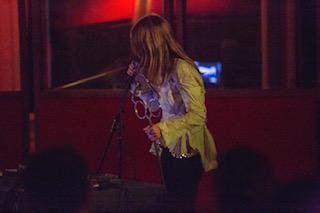Sophie Sleigh-Johnson
Primary page content
Sophie Sleigh-Johnson's MPhil/PhD Art research project
Marsh Hermeneutics: Performing Sites of Disorientation
The aim of this thesis is to perform an originary ‘Disorientation’ of place: one that attempts to tune into and map the damp technological patina of the past as a willing dis-placement of the present.
Disorientation is a theoretical term I take from philosopher Bernard Stiegler – and through which he, after Derrida, locates the historical ruptures brought about by successive phases of technology as externalisations of memory, thereby making them the medium of individual and collective individuation.
My aim is to move an understanding of Disorientation from this solely theoretical realm to that of practice.
Contra thinking Stiegler’s Disorientation solely as an effect of memory’s externalisation, this thesis perversely attempts to conjure that which has never occurred in the past, and thus re-enacts what is not indexed as nostalgic loss.
Through the mobilisation of a series of props and conceptual personae that call up different timescales latent in place, Re-enactment is never a repeated moment as such, but a flareup of Disorientation that returns as repetition in difference.
This is uniquely understood not only at the material level of place itself, but as its originary mode: a destabilising of the very ground thereof.
In the dissertation, Chapter 1 sets the scene in the marshes of ancient Mesopotamia, as figured in the prop of the cuneiform tablet, the earliest known writing. Performing the cuneiform tablet, I manifest the ‘Marsh Regime’ as the first pre-existent technics, and the ur-form of Disorientation.
Chapter 2 is a performative hagiography of artist Antonin Artaud and his methodology, including props, itinerancy and hole making, adumbrating his spell-casting practice as an equivalent imbrication of the technological with the geological.
Chapter 3 formulates Re-enactment as a form of geological Dérive, through an emphasis on contingent autofiction and the flickering de/territorialising of parochial exchanges between modes of occulture and 1970s situation comedy. All these conceptual resources operate as further locales of Disorientation, to be opened up though a Marsh Hermeneutic.
In my multi-disciplinary art practice, these revenant zones are mapped across radio, sculptural installations; Re-enactment performances; printmaking, and spoken word.
As in the thesis, who’s at-once magical and technical touchstone is the cuneiform tablet, props and personae recur repeatedly: the cane, Anton Artaud, the carrier bag, Leonard Rossiter, the Holsten Pils can: all are galvanising artefacts that activate other timescales, as a repetitive and inter-temporal relationship with the terrain that moves between Disorientation as mode and effect.
Likewise, a methodology of thinking and writing through the chapters is reticulated and vectored one through the other, dis-placing time and site.
In seeing different zones of Disorientation as flickering between the mythic and the located logic of a Marshography, the thesis argues for an intensive experience of landscape that is both an affective and deceptive territory, whilst raising the mode of the parochial and the genre of the sitcom to an existential mandate.
If place is understood as originary technics, damp is the spiritual technology of the twenty first century, with its stain and patina, the marsh’s essential Blind Spot.
Disorientation is the currency of spatio-temporal collaging, qua the originary force of life: an intervention on the ground of individuation, because the parochial ground rock of place is sempiternally deranged.
Supervisors
Primary: Professor Michael Newman
Secondary: Professor Kristen Kreider
Website
